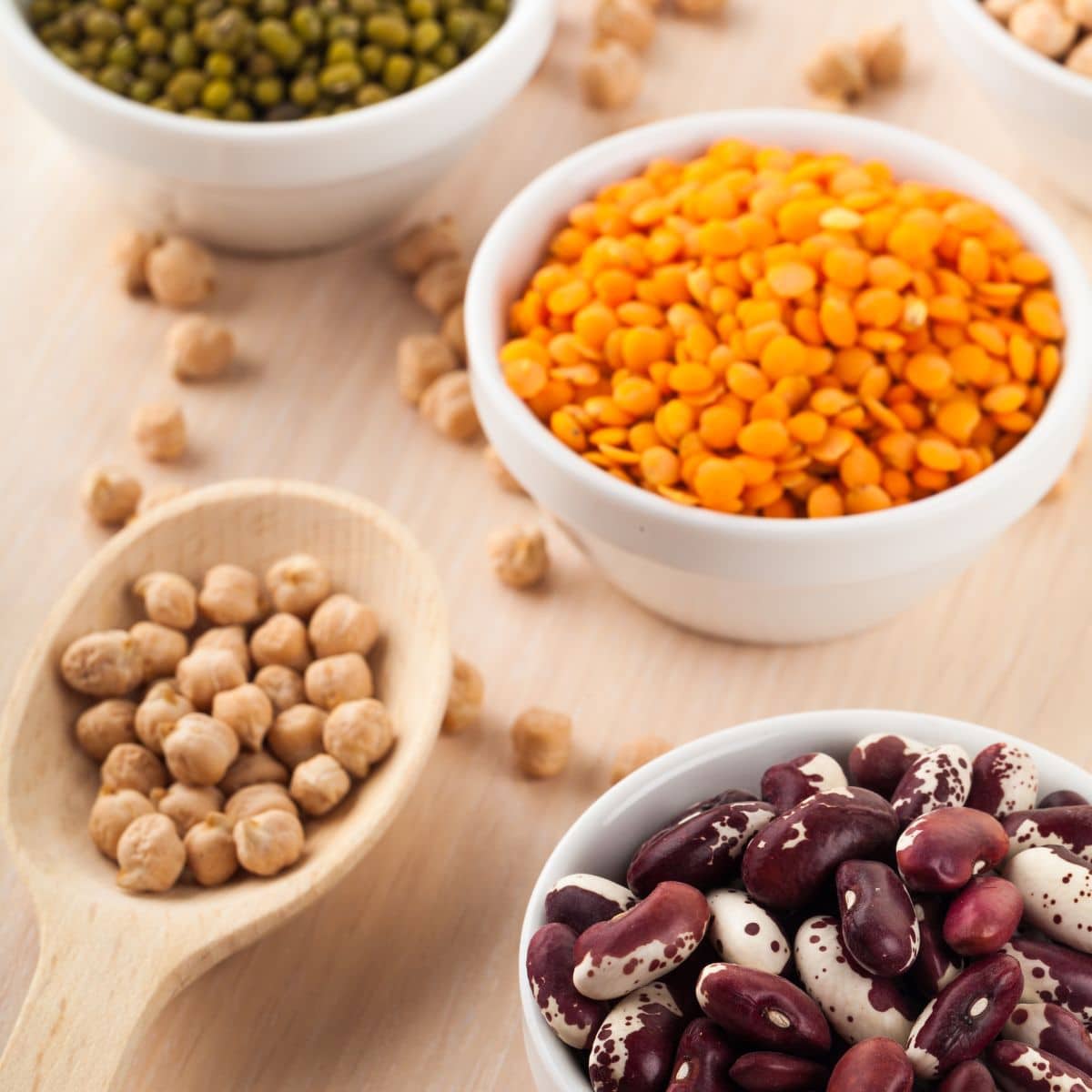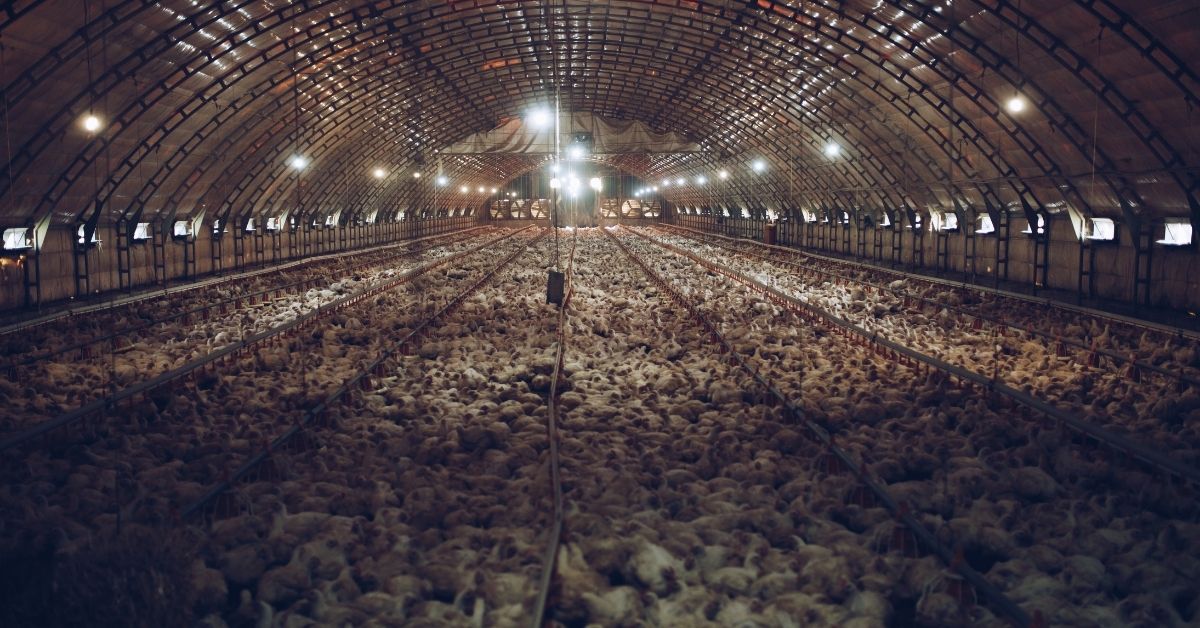

Protein is a much-misunderstood topic in our society. In this article, you will learn the role of protein in the body, where it comes from, and whether we need animal foods to obtain enough. But first, we should answer the most basic question: what is protein?
A protein is any one of a group of complex organic, nitrogenous compounds that form the principal constituents of the cell protoplasm. You can think of proteins as making up the “guts” of the cells that are the building blocks of our body. Put another way, proteins make up many of the structural and functional components of our cells. For example, they can act as organic catalysts in the form of enzymes, messengers such as peptide hormones, antibodies protecting us from microorganisms, or carrier agents in our blood transporting oxygen and other gases.
Zooming In: Amino Acids
All proteins are composed of specific combinations of amino acids. An amino acid is any one of a class of organic compounds containing a certain amino and carboxyl group. Although there are dozens of naturally occurring amino acids, the proteins in our body are derived from just twenty. Of these twenty amino acids, our body can adequately synthesize eleven internally. The other nine, called essential amino acids, must be obtained from our diet: histidine, isoleucine, leucine, lysine, methionine, phenylalanine, threonine, tryptophan, and valine.[1]
Importantly, although our bodies cannot produce the essential amino acids, they can recycle them. We will explore the implications of this concept later. For now, understand that the diet must provide enough essential amino acids to replace everyday losses. These obligatory losses occur following the use of amino acids to produce things like purine bases, creatine, and epinephrine, which are eventually excreted from the body after serving their purpose.
Without dietary sources of the essential amino acids, the body’s protein reserves become depleted, eventually leading to death.
Protein Digestion and Metabolism
The proteins of plants and animals are useless to us unless we can break them down into their constituent amino acids and absorb them. This is a key concept: our digestive systems cannot absorb large protein molecules, only the smaller amino acids and peptides. Once absorbed, these amino acids become the raw materials from which our body can synthesize the many proteins that serve many vital functions.
Dietary protein digestion begins in the stomach with exposure to the enzyme pepsin, which is secreted in the digestive juices and activated by hydrochloric acid. Contrary to popular opinion, hydrochloric acid does not digest protein but merely creates an appropriate medium for pepsin to work.[2] Following the secretion of hydrochloric acid, the pancreas and the mucosal cells of the small intestine produce other protein digestion factors (proteolytic enzymes). Once the dietary protein molecules have been broken down into their constituent amino acid components, absorption can take place through the mucosal cells of the small intestine.
At this point, the body is dealing with more than the amino acids contained in whatever food it has just ingested, because eating stimulates the digestive tract’s secretion of endogenous protein derived from the sloughing of intestinal cells and used-up digestive enzymes.[3] These recycled proteins are a rich source of essential amino acids. This mixing of endogenous and dietary protein is another key concept. Until it was discovered, people generally believed that to absorb and utilize the essential amino acids in the diet, the diet must contain all the amino acids in certain proportions, presented at the same time. Studies by Nasset demonstrated that this was not the case and that regardless of the amino acid mix of a meal, the intestinal tract maintains a remarkably similar ratio of essential amino acids.[4] This mixing of endogenous protein is the body’s way of regulating the relative concentrations of the amino acids available for absorption.
We now know that this reutilization process plays a major role in maintaining the balance of amino acids in the body. According to an expert report on protein requirements, “the daily turnover of body proteins is, in fact, several-fold greater than the amino acid intake, showing that the reutilization of amino acids is a major contributory factor to the economy of protein metabolism.”[5] By this recycling mechanism, the body can take “incomplete” proteins and make them complete. These concepts are not new—they were reported in the 1983 edition of Modern Nutrition in Health and Disease—yet many people still do not understand them.
Once absorbed, the combination of endogenous and dietary protein passes to the liver by the portal vein. The liver monitors the absorbed amino acids and adjusts their metabolism rate according to bodily needs.

Misconceptions Persist
The mistaken belief that a diet must contain all the amino acids in certain proportions, presented together, dates back to 1914 when Osborn and Mendel studied the protein requirements of laboratory rats.[6] Their finding that rats grew faster on animal protein than on vegetable sources was followed up by more rat studies by Elman in 1939 using purified and isolated amino acids.[7]
This earlier research did not even deal with amino acid absorption, and it falsely stated that the essential amino acids must be present at the site of protein synthesis within the liver, kidney, or muscle cells. Not yet understanding the recycling effect of the body’s amino acids, they assumed that the only source of protein was the diet.
We have learned a lot since 1939. However, many so-called nutrition experts continue to advance this ancient concept, which is the basis of many protein combining and protein quality arguments.
How Much Protein Do We Need?
This question has been a hotbed of scientific—and unscientific—debate since 1830 when a Dutch scientist named Mulder coined the term protein.[4] In 1865, Playfair in England presented studies that led him to believe the diet of the average healthy man should contain 119 grams of protein a day.[8] Later, a man named Voit studied Munich brewery workers and found they consumed 190 grams of protein daily; based on his studies of brewery workers, Voit advocated 118 grams of protein per day.[9] It was not until 1913 that Hindhede looked up the mortality rates of Voit’s brewery workers and discovered that most of these individuals died very young.[10] Fast forward several decades to 1947, when the University of Rochester laboratories had a project to establish the essential amino acid requirements of the adult male rat.[4] To keep the intake of calories and nitrogen constant, the animals were fed a synthetic diet by a stomach tube. It is questionable whether we can extrapolate from this type of study.
More recent studies of human protein metabolism have used nitrogen balance data as a parameter. Nitrogen balance studies compare the total amount of nitrogen in the form of dietary protein with the total amount of nitrogen excreted by the body through the urine, feces, integumentary system, sweat, hair, semen, menstrual fluid, and even the breath. The thinking behind nitrogen balance studies is that the body must be getting enough to maintain balance if the amount of protein eaten is as much as that given off.
Lost in much of the discussion about how much protein we need is the fact that protein deficiency is virtually impossible to achieve, provided a person eats a varied, calorically sufficient diet. All natural foods (e.g., lettuce, berries, and nuts, but not oil or sugar) contain at least some protein, and even a diet devoid of concentrated protein sources, such as animal products, nuts, and legumes, can easily meet protein needs. Most conventional nutrition thinking ignores this fact. The contribution of plant foods to our protein needs is so commonly overlooked that, for many, the word protein remains synonymous with meat and a select few meat substitutes (e.g., tofu), as evidenced by countless restaurant menus.
Most conventional diets today contain only token amounts of the protein-containing plant foods on which our body thrives (legumes, whole grains, vegetables, nuts, and fruits); instead, they rely on high-fat, high-protein animal products and a conglomeration of refined carbohydrates, to the lasting detriment of our health.
Are We Built to Eat Meat?
Even a brief look at comparative anatomy illustrates quite clearly that man is not designed to be a carnivore. And just because our bodies have a vital need for a substance does not mean that twice or three times our need is even better. In the case of protein, the concept that more is better is dead wrong.
It is interesting to note that most of our teeth are flat for grinding grains and vegetables-and that our hands are better designed for gathering than for tearing flesh apart. Our saliva contains alpha-amylase whose sole purpose is the digestion of carbohydrates. Alpha-amylase is not found in the saliva of carnivorous animals. Carnivores have the capacity to eliminate large amounts of cholesterol, whereas our livers can excrete only limited amounts. Like herbivores, we sweat to cool our bodies rather than pant like carnivores.
Of all animals that include meat in their diet, man is the only animal that is unable to break down uric acid to allantoin. This is due to the fact that man does not possess the necessary enzyme uricase. This leads to an increased possibility of an accumulation of uric acid in the body when animal products are eaten. (Uric acid is an intermediary product of metabolism that is associated with various pathological states, including gout.)

Caution: Where You Get Your Protein from Does Matter
Meat eaters have massively increased levels of bile acids compared to vegans.[11] Animal products are also a common source of parasites and contamination (e.g., Trichinosis found in pork and pork-contaminated beef and Salmonellosis in milk products).[12] Numerous chemical agents, such as carcinogenic nitrates, are added to animal products to slow their decay, improve their color, and alter their taste. Most animal products undergo significant heat treatment before consumption, which can present serious problems. For example, a one-kilogram charbroiled steak contains as much of the cancer-causing benzopyrene as 600 cigarettes.[13] The heating of any fat, including the fats in animal products, can cause peroxidation and the formation of free radicals, extremely reactive molecules capable of damaging almost any cell of the body. Free radicals have been shown to cause alterations to collagen and elastin tissue, leading to premature aging of the skin and connective tissue.[14] They contribute to the accumulation of intracellular debris, such as lipofuscin, and are an important component in the aging process.[15]
In addition to parasites, bacterial infestation, toxic poisons, carcinogenic agents, and free radicals, animal products suffer from the problem of biological concentration.[16] Animals consume large quantities of grain, grass, etc., which are, to a greater or lesser extent, contaminated with herbicides, pesticides, and other agents. Additionally, animals are often fed antibiotics and treated with other drugs and toxic agents. These poisons accumulate in the animal fat and concentrate in milk and flesh.
As if this weren’t enough, animal products are completely devoid of fiber and extremely high in protein.[17] Despite what millions of dollars of meat and dairy industry advertising would have you believe, it is the excess of protein, not a deficiency, that threatens our health. Excess protein intake has been strongly implicated as a causal agent in many disease processes, including kidney disease, various forms of cancer, osteoporosis, and a host of autoimmune and hypersensitivity disease processes.
It is virtually impossible to design a diet consistent with the overwhelming evidence in the scientific literature dealing with nutrition so long as a substantial amount of animal products remain in the diet. The irony is unmissable: the chief argument used to promote consuming animal products (the purported need for large quantities of protein) is the greatest reason for avoiding them.
What Are We?
Finally, even a brief look at comparative anatomy illustrates that we are not designed to be carnivores. Just because our bodies have a vital need for a substance does not mean that double or triple the amount will be even better. The idea that more protein is better is dead wrong.
With all this in mind, the question of where we get our protein is—perhaps surprisingly—even more relevant than most realize. However, the usual framing of the question is backward. Instead of being concerned about protein deficiency, we should seriously consider the harm that overconsumption of animal protein has had and will continue to have on our personal and planetary health.
References
- Lopez MJ, Mohiuddin SS. Biochemistry, Essential Amino Acids. [Updated 2024 Apr 30]. In: StatPearls [Internet]. Treasure Island (FL): StatPearls Publishing; 2024 Jan-. Available from: https://www.ncbi.nlm.nih.gov/books/NBK557845/
- Heda R, Toro F, Tombazzi CR. Physiology, Pepsin. [Updated 2023 May 1]. In: StatPearls [Internet]. Treasure Island (FL): StatPearls Publishing; 2024 Jan-. Available from: https://www.ncbi.nlm.nih.gov/books/NBK537005/#
- Dave LA, Montoya CA, Rutherfurd SM, Moughan PJ. Gastrointestinal endogenous proteins as a source of bioactive peptides–an in silico study. PLoS One. 2014;9(6):e98922. Published 2014 Jun 5. doi:10.1371/journal.pone.0098922
- Nasset ES. Role of the digestive tract in the utilization of protein and amino acids. J Am Med Assoc. 1957;164(2):172-177. doi:10.1001/jama.1957.62980020004012
- Joint FAO/WHO/UNU Expert Consultation. “Principles of estimating protein requirements.” Energy and Protein Requirements (1985). Online access: https://www.fao.org/4/aa040e/AA040E05.htm#ch5
- Osborne TB, Mendel LB, Ferry EL, Wakeman AJ. The amino-acid minimum for maintenance and growth, as exemplified by further experiments with lysine and tryptophane. J Bio Chem. 1916;25(1):1-12. doi:10.1016/S0021-9258(18)87509-3
- Elman R, Weiner DO. Intravenous alimentation: with special reference to protein (amino acid) metabolism. JAMA. 1939;112(9):796–802. doi:10.1001/jama.1939.02800090006002
- Weiler M, Hertzler SR, Dvoretskiy S. Is It Time to Reconsider the U.S. Recommendations for Dietary Protein and Amino Acid Intake?. Nutrients. 2023;15(4):838. Published 2023 Feb 6. doi:10.3390/nu15040838
- Voit C. Ueber die kost eines vegetariers. Zeitschr f biologie. 1889;25(261). Cited by Chittenden RH in Physiological economy in nutrition (F.A. Stokes, 1904).
- Hindhede M. Protein and nutrition: an investigation. Ewart, Symour & co. (1913).
- Trefflich I, Marschall HU, Giuseppe RD, et al. Associations between Dietary Patterns and Bile Acids-Results from a Cross-Sectional Study in Vegans and Omnivores. Nutrients. 2019;12(1):47. Published 2019 Dec 23. doi:10.3390/nu12010047
- Heredia N, García S. Animals as sources of food-borne pathogens: A review. Anim Nutr. 2018;4(3):250-255. doi:10.1016/j.aninu.2018.04.006
- Lijinsky w, Shubik p. Benzo(a)pyrene and other polynuclear hydrocarbons in charcoal-broiled meat. Science. 1964;145(3627):53-55. doi:10.1126/science.145.3627.53
- Silva SAME, Michniak-Kohn B, Leonardi GR. An overview about oxidation in clinical practice of skin aging. An Bras Dermatol. 2017;92(3):367-374. doi:10.1590/abd1806-4841.20175481
- Höhn A, Grune T. Lipofuscin: formation, effects and role of macroautophagy. Redox Bio. 2013;1(1):140-144. doi:10.1016/j.redox.2013.01.006
- Popek E. Environmental chemical pollutants. Sampling and Analysis of Environmental Chemical Pollutants (second edition). 2018:13-69. doi:10.1016/B978-0-12-803202-2.00002-1
- British Heart Foundation. Are you eating enough fibre? Heart Matters. Online access, November 14, 2024. https://www.bhf.org.uk/informationsupport/heart-matters-magazine/nutrition/fibre#:~:text=What%20is%20fibre?,is%20fibre%20good%20for%20us?
Copyright 2025 Center for Nutrition Studies. All rights reserved.
Deepen Your Knowledge With Our
Plant-Based Nutrition
Certificate
Plant-Based Nutrition Certificate
- 23,000+ students
- 100% online, learn at your own pace
- No prerequisites
- Continuing education credits











